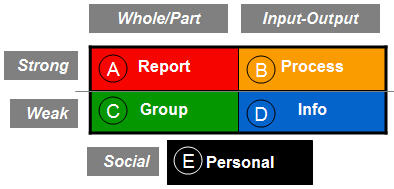|
Two whole/part link types, Reporting (A) and Group (C), offer multiple ways to represent parent/child, group/member relationships
|
Two input-output link types, Process (B) and Information (D), offer multiple ways to represent before-after, upstream-downstream, sender-receiver relationships
|
Two strong organization link types, Reporting (A) and Process (B), are few in number but very forceful in their impact
|

Personal (E) links connect people (employees) in an internal social network separately threaded through the organization network of positions and relationships
|
Two weak organization link types, Group (C) and Information (D), are influential and may be many in number
|
In developing a taxonomy of links for organizations, we have sought to make useful categories. However, the OrgScope tool, which manages these link types, also allows any and all link types to be used or not used, turned on or off, analyzed or not. In time, we will learn which links to count for what purposes. This taxonomy will earn a place in the new management science through its use, or not, in practice.
|
|
<-- Insert Local div here with w x height
Content for id "content" Goes Here
Use .L2menu2 format for secondary menu
Use keywords early and prominant
Check: Title! Template Properties (meta descriptions & keywords)
Nodes are the easy part, links the hard.
Networks are known by their nodes, hence “organization networks” made of organizations, groups, and positions as distinguished from “people networks” or “social networks,” where the unit of representation is individual human beings.
Not so easy with links.

